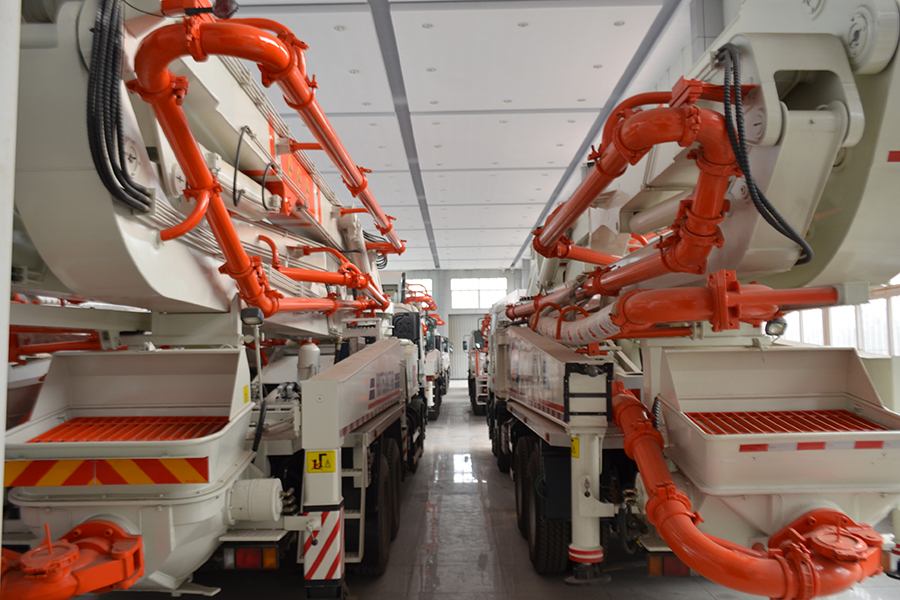| EPDAS18 | 11-06-2024 | comment profile send pm notify |
A Boom Pump Is A Type Of Concrete Pump Used For Delivering Liquid Concrete To Hard-To-Reach Areas, Primarily In Large-Scale Construction Projects. It Features A Hydraulic Arm (Boom) That Can Extend And Maneuver To Different Heights And Angles, Allowing The Pump To Place Concrete Precisely In Elevated Or Difficult-To-Access Locations Such As High-Rise Buildings, Bridges, And Large Industrial Sites.
uses Of A Boom Pump:
1. large Construction Projects: Boom Pumps Are Commonly Used In Large-Scale Construction Projects Such As High-Rise Buildings, Bridges, And Large Foundations Where Concrete Needs To Be Delivered Over Long Distances.
2. precision Placement: The Extendable Boom Allows For Precise Placement Of Concrete In Hard-To-Reach Areas, Such As The Upper Floors Of High-Rise Buildings Or Deep Excavation Sites.
3. flexible Reach: They Can Reach Heights And Distances That Traditional Concrete Delivery Methods (Like Truck Mixers) Can’t, Making Them Ideal For Complex Layouts.
4. fast Delivery: They Can Pump Large Volumes Of Concrete Quickly, Improving Overall Project Efficiency And Helping To Maintain Project Timelines.
5. variable Terrain: Boom Pumps Can Maneuver Over Obstacles (Like Other Construction Equipment) Thanks To Their Flexible Boom, Making Them Suitable For Various Site Conditions.
6. reduction Of Manual Labor: By Automating The Concrete Pouring Process, Boom Pumps Reduce The Need For Manual Labor To Lay Down Concrete, Thus Minimizing The Risk Of Injury.
advantages Of Boom Concrete Pumps:
efficiency: Boom Pumps Can Deliver Large Volumes Of Concrete Quickly, Reducing Project Timelines.
precision: The Ability To Position The Boom Accurately Minimizes Waste And Ensures That Concrete Goes Exactly Where Needed.
accessibility: The Boom Can Reach Difficult Locations That Conventional Pumps May Not Access Easily, Including Over Obstacles Like Other Equipment Or Walls.
reduced Labor Costs: Automating Concrete Placement Decreases The Need For Large Crews, Lowering Labor Costs And The Potential For On-Site Injuries.
versatility: Suitable For Different Concrete Types, Including Standard Mixes And Those Requiring Additives.
disadvantages:
cost: Renting Or Purchasing A Boom Pump Can Be More Expensive Than Traditional Concrete Delivery Methods.
setup Time: Although Quicker Than Some Methods, Setting Up A Boom Pump Can Take Time, Especially For Larger Models.
site Limitations: Requires Sufficient Space For Setup And Operation, Limiting Use In Very Confined Sites.
boom Concrete Pumps Are Essential Tools In Modern Construction, Offering Precision, Speed, And Access To Areas That Would Be Challenging Or Impossible To Reach With Traditional Concrete Delivery Methods.
the Boom Concrete Pump Typically Consists Of Several Key Components:
automobile Chassis: This Provides The Mobility Needed To Transport The Pump To Various Locations Within A Construction Site.
concrete Pump: The Central Component Of The Boom Concrete Pump, Responsible For Generating The Pressure Needed To Convey The Concrete Through The Boom Arm.
boom Arm: A Telescopic And Articulated Arm That Can Be Extended And Manipulated To Reach The Desired Pouring Location. It Often Includes Multiple Sections That Can Be Independently Controlled To Achieve The Required Positioning.
pipeline System: This Includes The Hose And Piping That Connect The Concrete Pump To The Boom Arm, Ensuring A Smooth And Continuous Flow Of Concrete.
in Both The Construction Industry And Water Management Systems, Pumps Play An Indispensable Role. Whether It’s The Precision Placement Of Concrete In High-Rise Buildings Or Boosting Water Pressure In Plumbing Systems, Different Types Of Pumps Are Essential For Achieving Efficiency And Productivity.
concrete Pumps Can Be Classified Into Two Primary Categories: Boom Pumps And Line Pumps. Each Type Has Its Specific Applications And Operational Advantages.
1. concrete Boom Pumps: As Mentioned Earlier, Concrete Boom Pumps Utilize A Hydraulic Arm To Position The Concrete Accurately. They Are Often Used For:
high-Rise Buildings
bridges
large Foundations
boom Pumps Are Characterized By Their Reach And Efficiency, Making Them Essential For Modern Construction Demands.
2. line Pumps: Line Pumps, In Contrast, Do Not Have A Boom. They Consist Of A Pump Connected To A Series Of Hoses, Transporting Concrete Along The Ground To The Desired Location. While They May Not Offer The Same Height Capabilities As Boom Pumps, Line Pumps Are:
more Affordable
ideal For Smaller Jobs And Residential Projects
easier To Set Up In Confined Spaces
the Operational Principle Of Boom Concrete Pumps Involves Using A Hydraulic System To Power The Pump And Boom Arm. Concrete Is Fed Into The Pump, Which Then Uses Pressure To Push It Through The Pipeline System And Out The End Of The Boom Arm. This Process Allows For Precise And Efficient Placement Of Concrete, Reducing The Need For Manual Labor And Speeding Up Construction Timelines. Boom Concrete Pumps Are A Valuable Addition To Any Construction Project, Offering Improved Efficiency, Accuracy, And Safety In Concrete Placement Tasks. |
||





















.jpg)
.gif)

.jpg)








.jpg)








